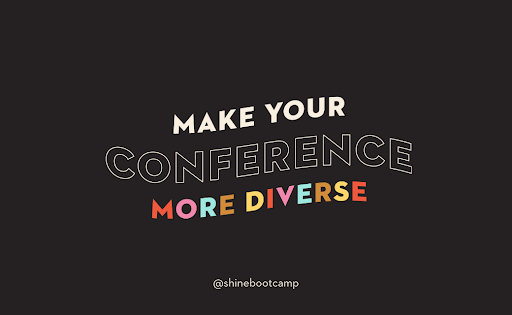
Putting on events is a true test of a person’s grit. The outcomes are visible to everyone. Failure is not an option. Deadlines are firm. And nothing goes exactly to plan. On top of that, it’s an emotional rollercoaster. Add in a global pandemic where you’ve been forced to shut down or go virtual and let’s just put it this way: you are a hero. I feel you. Because as a conference organizer, I’ve been there.
On top of all that, finding fresh, diverse speakers for your conference is important to you – but that doesn’t mean it’s easy. And experience has taught you that in our celebrity-obsessed culture, recognizable names drive registration. But you have the unique opportunity to find those rising stars – and give them the stage.
How are you making your decisions around your speaker lineup? Where can you find new, fresh speakers? How can you prioritize a diverse speaker lineup?
Driving diversity at your conference without being performative
Back in 2017, like many other women, I got tired of seeing all-male conference lineups. The common excuse? There “aren’t enough qualified female speakers.” But what did that even mean? Did it mean there weren’t qualified women in their fields, with loads to teach and share? Or did it mean women were systematically at a disadvantage? (Hint: it’s the latter, but more on that later.)
Rather than talk about the problem, Alejandra Porta, Amy Wood, and I wanted to be part of the solution. After this viral post struck a serious chord, Shine Bootcamp, a professional speaker accelerator for women, was launched as a means to equip women with the confidence, tools, and experience to land speaking gigs.
While some may have applauded our initial efforts and our bold mission, we recognized it wasn’t good enough. And still isn’t good enough. Getting more women on stage was (and still is) an important topic, but all too often that translates to more white women.
Not only that, we recognize that our programs have limitations. We can work with women to build their confidence and speaking abilities. But without addressing the systemic barriers which prevent them from speaking up and from taking up space, we will continue to see poor representation not just on stages, but in all spaces where power resides.
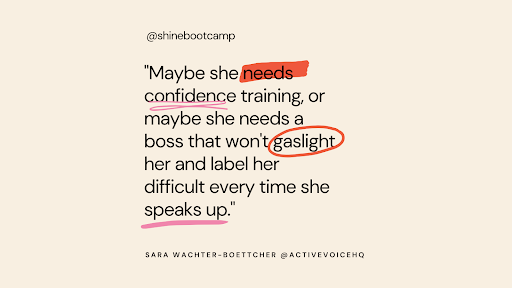
This past year, social justice movements took center stage, and activism became a bigger part of people’s lives and identities. While more attention is rightfully being paid to diversity, inclusion, and intersectionality, I urge you to go beyond trending topics. I challenge you to go beyond performative actions.
Before you engage speakers, start with self-reflection and education
I tend to avoid writing about “mainstream topics.” They get so much attention that it often feels like I’m just contributing to the noise. (Alas, the wonderful Editorial Director at Prezi, Lorraine Lee, thought all of you would appreciate my take on the topic).
With that said, I’ve read my fair share of articles that talk about how conference leaders and organizers can make their conference lineups more diverse. Yet, none of them talk about the education and self-reflection a conference organizer should do – what an organization should do – before diving into tangible stuff, like approaching potential speakers.
Also, before I dig in, I wouldn’t call myself an expert in diversity, equity, and inclusion (DEI) by any means. As a white woman with privilege, I consider myself an ally, have made mistakes, learned and am currently learning. Most importantly, I am challenging and calling on my fellow conferences and event organizers to do better.
While I am personally not a fan of the term “DEI” as it feels very corporate and something someone tells you to do, rather than something you want to do, it’s important that you commit real time, energy, and resources educating yourself (and your team, if need be).
Take some time and give yourself space to ask some difficult questions, like why do you want to secure a diverse speaker lineup? What is your motivation? What is your organization’s motivation? Are you committed to allocating time and resources to creating a safe for all speakers and attendees?
Then, spend some time really becoming aware of your biases, specifically as it relates to selecting speakers. I know I’ve made my fair share of mistakes (that I wrote about in that viral post in 2017), but do the work yourself so you know where you have gone wrong in the past and how you can course-correct for the future.
Perhaps I am assuming you have all the decision-making power over who gets selected as a speaker. But more likely that’s not the case – after all, putting on a conference takes a village. This means there are often different opinions and power dynamics at play when it comes to selecting speakers.
Improve your selection process and bring in decision-makers with different perspectives to avoid selection bias. The decision makers, regardless of their identities, need to share a commitment to change.
It is important to remind yourself to take an expansive view of what “a diverse speaker lineup” really means
Yes, please source and support speakers who are women. Yes, support Black speakers. Yes, engage Asian speakers. But diversity doesn’t stop there. It’s also important to think about the LGTBQIA+ community. It’s just as important to think about people with disabilities (both invisible and visible disabilities). It is very important to think about Indigenous Peoples — the “I” in BIPOC that are all too often left out. Lastly, when it comes to speaking opportunities, folks whose first language is not English are often discriminated against because of their accents or their gravitas.
There are also some long-held beliefs that we need to challenge if we are going to truly diversify conferences. The most fluent, well-known, and confident speakers are not always the most competent.
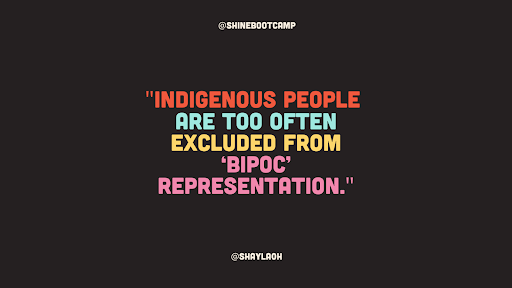
I want to mention one huge caveat to everything I just wrote. If you are not actively doing “the work,” but you are approaching speakers from diverse backgrounds, you are engaging in tokenism, “the practice of making only a perfunctory or symbolic effort, especially by recruiting a small number of people from underrepresented groups in order to give the appearance of sexual or racial equality.”
Tokenism is not only cringeworthy, it’s also harmful. Here’s an example: let’s say an event organizer hires a disabled speaker but pays no mind to ensuring the venue is wheelchair accessible. Harmful.
This translates to your marketing as well. When you market your conference, don’t heavily highlight a speaker’s identity, center and lead with their expertise. And when you get speakers to tackle a topic, consider this:
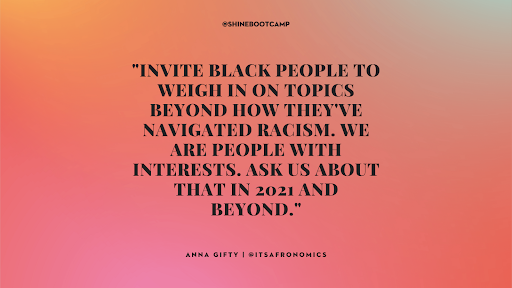
Partner with organizations doing “the work”
The reality is that we spend a lot of time with people who look and think like we do. Expand your bubble and look for other organizations to work with who drive diversity and inclusion.
Reach out, support, and partner with organizations specifically and actively working to train speakers, educate conference organizers, and make conference lineups more diverse, and thus conferences more inclusive. Organizations like:
- Shine Bootcamp
- Women and Color
- Women Talk Design
- The Women/Womxn, Black, Indigenous, POC, and Inclusivity Speaker Initiative
- Innovation Women
Give new speakers a chance (and provide them with additional support)
It’s important to remember that people are caught in a classic Catch-22: They can’t become a speaker without experience, but can’t get experience because they aren’t speakers. Focus on what someone does have: potential, a different perspective, a story that needs to be heard.
Because the truth is (and I say this as a former events organizer), audience members are far more interested in someone with something interesting to say. They prefer that over polished mediocrity any day. Find that someone with something interesting to say.
And remember: Speaking is a learned and acquired skill (and there are accelerator programs, like Shine Bootcamp, that support speakers).
At first glance, these speakers may *seem* less confident. They may sound less assertive or “professional.” Your instinct may tell you they aren’t a fit for your event. Override your gut instinct and instead provide guidance and coaching. Help new speakers reach the level of quality you and your attendees expect; help them succeed. Even just offering this can draw proposals from strong candidates. Speaking from experience, I think you’ll be pleasantly surprised.
Adding to that same sentiment, the more a speaker speaks, the better they become. By getting an up-and-coming speaker on stage, you show underestimated people and hopeful speakers that their voice and their professional development matter.
Also, in my experience, a new speaker will work twice as hard to understand your audience and craft a compelling talk if you give them the chance.
Compensate your speakers fairly and equitably: Respect the time, energy, and knowledge that goes into a great talk
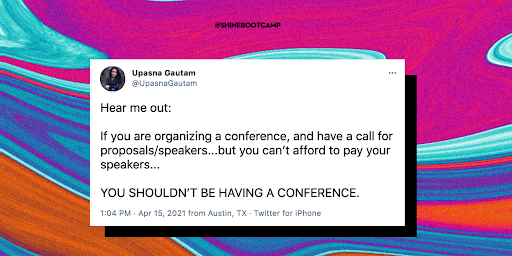
Preparing an engaging talk takes hours of research, preparation, and practice. Not to mention, a presentation usually represents a career’s worth of work. Conferences need to recognize and respect the true cost of speaking. And that doesn’t always *have* to mean money. For example, there are nonprofits, grassroot events, and community-driven conferences that are true labors of love. I know some conferences who break even (at best) and more realistically lose money. Many event organizers are volunteers. I’ve been there. I see you, hear you, and feel you.
But recognize that speaking for free isn’t a realistic option for many people, especially people who are most disadvantaged by a large wealth gap. Paying speakers can help balance the scales.
According to Bobby Carlton at Innovation Women, half of all event organizers report having zero budget for speakers. This keeps the onstage crowd looking homogeneous, further limiting diversity.
If you fall into this no-speaker budget bucket, I highly encourage you to look at your budget to see what you can change. Speakers are the core of your event, after all. But if you *really* can’t make the numbers work (I get it, conferences are very expensive), make sure you are 100% upfront, fair, transparent, and equitable. Be sure to tell them what you can offer. Where your funds go. What your mission is and what impact a speaker could make.
I also recommend, at the very least, communicating (and committing to) something like this:
“Currently, we are not offering speakers any monetary payment for their much-valued and appreciated contributions. That being said, we recognize that opportunities aren’t equal for everyone and we are committed to intentionally building a diverse speaking roaster. If you fall in this category and feel like you can’t commit, we’d love to know what compensation would look like for you.”
On that note, it’s important you understand what a speaker needs and values. Is it money? Does the speaker see your conference as a marketing channel? Do they value access to your audience? Is it flights + hotels covered (if IRL)? Is anyone else getting paid? Is it a mix of all of the above?
I want to recognize that payment around speaking can be hard and nuanced to navigate for both speakers and conference organizers alike because there are benefits that go beyond money. Take single mom and full-time Founder, Amanda Goetz, as an example:
“Real talk: living off of a founder’s salary is hard / stressful (esp when you have 3 humans to take care of). I struggle with wanting to charge for speaking engagements because it helps with brand building.” (read her original tweet here)
On top of that, be conscious that the confident, seasoned, and privileged keynote will advocate for themselves very well. If a privileged speaker gets paid while another doesn’t, you aren’t addressing the systemic barriers at play. I know a conference who paid a white man to speak, while no one else got paid. Not cool.
Have a transparent + open call for speakers
Have a call for speakers. It might sound obvious, but many conferences don’t and it’s such a missed opportunity.
Once you have an open call for speakers, make sure you include detailed information about your selection process, your criteria, what you offer speakers, and your commitment to making the event inclusive and safe.
And remember: nuance and language matter.
I love this bit from Sarah Milstein: “If you say that you’re looking for people with ‘advice and expertise to share’ rather than ‘experts,’ you avoid suggesting that you’re interested only in people already recognized in the field. (Anecdotally, women are less likely than men to refer to themselves as experts, so as a bonus, you also avoid accidentally excluding them.)”
Now what?
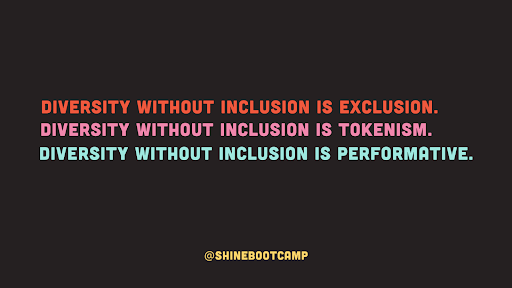
So, now that you have a diverse speaker lineup, what’s next? The work doesn’t stop. Don’t forget, you need to make sure your conference, the space you create for speakers and attendees alike, is inclusive and safe. Ensure the same care you took to curate your speaker lineup is reflected in the conference itself (which is another post for another day).
About the author
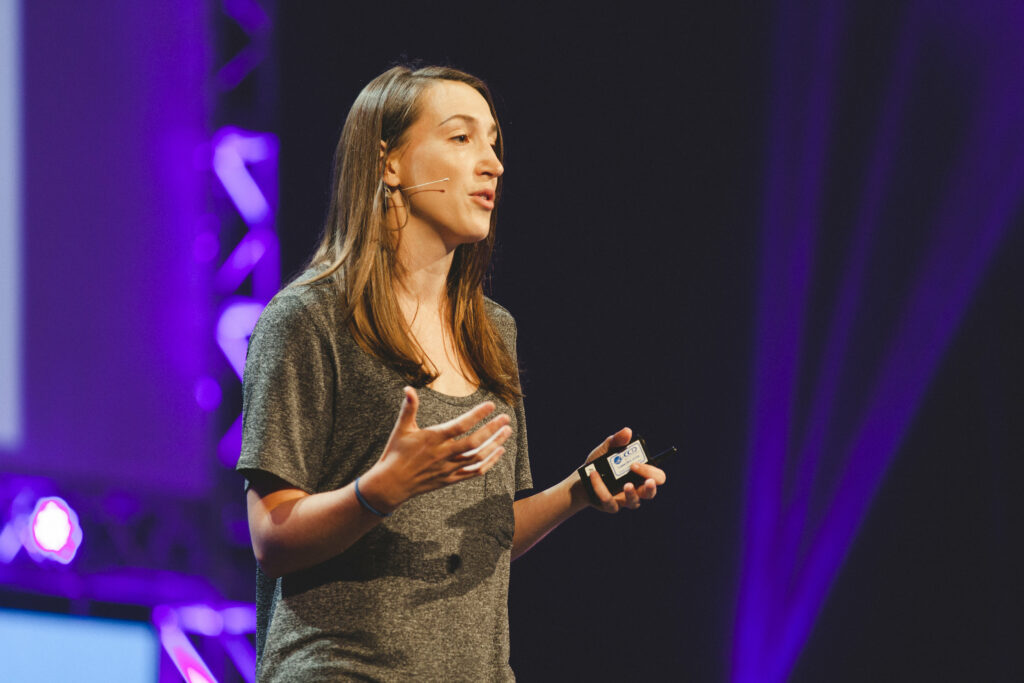
Stefanie Grieser is the Co-Creator of Shine Bootcamp, a professional speaker accelerator for women and host of the Shine Speaker Showcase. You can follow Shine on Instagram and Twitter.